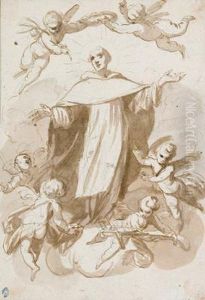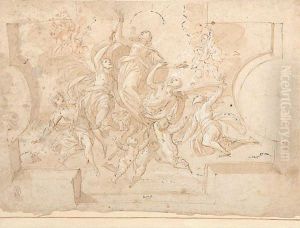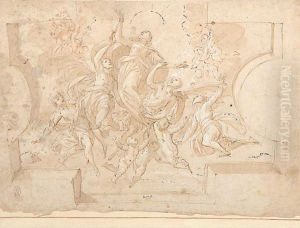Pompeo Ghitti Paintings
Pompeo Girolamo Batoni, known as Pompeo Ghitti, was an Italian painter of the Baroque period, born in the year 1613 in Brescia, a city in the Lombardy region of Italy. Ghitti's artistic journey began in his hometown, where he was initially trained. However, his talent and ambition drove him to explore beyond the confines of Brescia, absorbing influences from the broader Italian art scene, which was vibrant with Baroque fervor during the 17th century. Despite the common mix-up with Pompeo Batoni, a later 18th-century artist, Ghitti's works and contributions to the Italian Baroque movement stand distinct.
Ghitti's body of work is characterized by religious and mythological themes, a hallmark of Baroque art, which sought to evoke emotion and bring viewers into a dynamic engagement with the artwork. His compositions often featured dramatic use of light and shadow, a technique known as chiaroscuro, which was popular among Baroque artists and helped to create a sense of depth and volume. Ghitti was particularly adept at depicting scenes with intense emotional expressions and dynamic movements, which were intended to stir the viewer's soul and encourage a deeper spiritual reflection.
Throughout his career, Pompeo Ghitti received numerous commissions from churches and religious institutions, which were the primary patrons of art in his era. His works can still be found in several churches and collections in Brescia and surrounding areas, serving as a testament to his skill and the esteem in which he was held during his lifetime. Despite his success, detailed records of his life and works are somewhat scarce, a common issue for many artists of his time. Nevertheless, Ghitti's contributions to the Italian Baroque movement remain significant, and his paintings continue to be studied and admired for their emotional depth and technical mastery.
Pompeo Ghitti passed away in 1703, leaving behind a legacy that would influence the generations of artists that followed. His style, characterized by its emotional intensity and technical precision, contributed to the evolution of the Baroque movement in Italy. Even though Ghitti may not be as widely recognized as some of his contemporaries, his work remains an important part of the artistic heritage of the Baroque period, showcasing the richness and diversity of Italian art in the 17th century.






